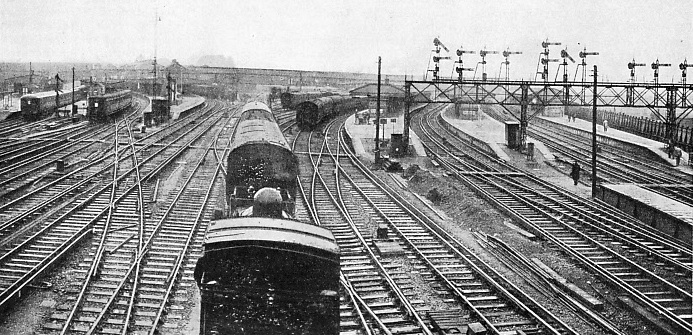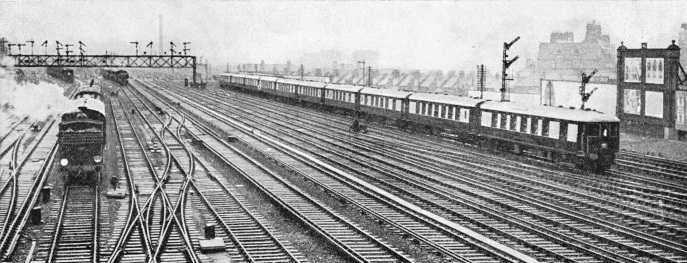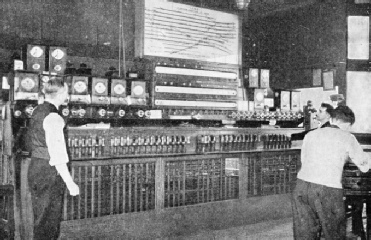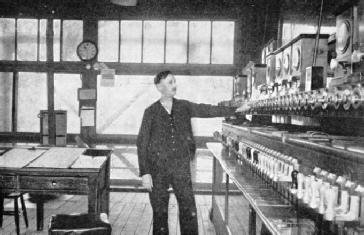An Important Link between Britain’s Northern and Southern Lines
FAMOUS RAILWAY CENTRES - 4

A GENERAL VIEW of Clapham Junction showing, on the extreme left, the Brighton lines, in the centre the West of England main lines, and to the right, the Windsor and Reading tracks. The total area enclosed by its platforms is 24¼ acres. Clapham Junction is the second largest station in Great Britain.
IT has been said, in a phrase that has become proverbial, that everyone one meets, sooner or later, under the clock of Charing Cross Station. Of another Southern Railway station - Clapham Junction - it may be said that eventually everyone passes through it.
Clapham Junction retains many distinctions even in an age in which the records of to-day become the common-places of to-morrow. It handles more passenger trains a day than any other station in the British lsles. lt is, taking all factors into account, entitled to call itself one of the world’s busiest railway stations. It is a focal point for the largest and busiest suburban electric railway traffic in the world, besides forming one of the gateways to Europe, America, and the East.
It adds to its other activities that of serving as one of the main transfer and interchange points for passenger and goods traffic passing between the main railway systems north and south of the Thames. Its name has naturally, therefore, become synonymous with that of a busy meeting-place. By one of the many curiosities of English railway geography, Clapham Junction is not situated in Clapham, but in the adjoining suburb of Battersea. The London and South Western Railway owned at one time a passenger station officially known as Wandsworth, which also was in Battersea. This structure was eventually replaced by a station to which it had originally been intended to give the name of Battersea Junction. The reason for the change of name “is a mystery”, says one historian, “unless we accept the usual explanation that it sounded more important, for it is very much in Battersea, and over a mile from Clapham, to which a branch was never proposed”. It is not quite clear at this date why Clapham should “sound more important” than Battersea; but, whatever the explanation, the fact remains that the name of one of the most famous railway stations in the world is based on an error in geography.
To understand why Clapham Junction should hold the record for passenger train movements, it is necessary to understand something of the history and geography of the railways south of the Thames, and of the special conditions existing on those lines, as far as short distance traffic is concerned. As well as dealing with the traffic of “foreign” companies, Clapham Junction serves both the Western (London and South-Western) and Central (London, Brighton and South Coast) Sections of the Southern Railway. Every train entering and leaving Waterloo Station - the busiest passenger terminus in the country - has to pass through the junction. Although the train movements at London Bridge are more numerous than at Waterloo, there are three stations at London Bridge - the through station used by the Eastern Section, the terminal station of the Central Section, and the small so-called “Low Level” station between them.
The main reason for the exceptionally heavy traffic movements at both Victoria and Waterloo is that the Southern Railway is predominantly a passenger-carrying system. There is no parallel to the immense suburban network within a radius of twenty-five miles of its numerous London terminal stations. The reason is that an exceptionally large proportion of the Southern's total route mileage of 2,186 lies within this small area.
The whole of the long- and short-distance passenger traffic in and out of Waterloo has to pass through Clapham Junction, which also handles much of the Brighton line traffic, including the majority of the sixty minutes non-stop expresses between London and Brighton. In addition, the station serves the West London Extension Railway, which affords a through route linking up the Southern main line with those of the Great Western and LMS Railways. It handles also a vast amount of interchange traffic in goods and parcels, and serves as well as a marshalling and assembling depot. The traffic density and strategical importance of the junction thus become intelligible.
The importance of Clapham Junction will be appreciated when it is remembered that from the beginning Waterloo was called on to handle a large and constantly growing traffic. The traffic grew in spite of the pessimistic predictions that were so freely made when the London and Southampton railway - predecessor of the London and South-Western - was first planned. It is to the credit of the company that from the outset it built with an eye to the future. In the year of the opening of Waterloo, which was built on a site “formerly occupied by hay stalls, cows yards, and similar nuisances”, the South Western chairman told his stockholders that “he company had placed on the railway between Nine Elms and Waterloo four distinct lines of rails, so that there should be no trouble or inconvenience in future in the traffic”.
The Junction’s Importance
But, although a running road with four tracks was remarkable in those early days, it shortly afterwards became necessary to enlarge the terminus by the building of the so-called Windsor Station. By 1879 fourteen platforms were already in use - an exceptional figure for the time when stations were small. To-day Waterloo has further expanded to twenty-one platform roads and two other tracks. The terminal approach, by way of Vauxhall and Queen’s Road (Battersea) Stations, is by eight tracks as far as West London Junction, where the tracks fan out to serve Clapham Junction. Clapham Junction has seventeen platforms and two through roads, without counting those used for shunting and other purposes.
It is interesting to speculate on what might have happened if, for reasons explained in "The Story of the Southern", the Brighton and the London, Chatham and Dover Railways had not both fixed on Victoria as a terminal site. The Brighton line did not reach the site of Clapham Junction until many years after the London and South Western. The original Brighton line terminus was at London Bridge, and Victoria Station was not opened until 1860, although a line between London and Brighton was in use throughout as early as 1841.
The third Partner, so to speak, in Clapham Junction is the West London Extension Railway. This line, which is five miles in length, possesses neither locomotives nor rolling-stock, and is jointly owned by the Great Western, LMS, and Southern Railways. It extends from Clapham Junction to Kensington (Addison Road), where it links up with the two and a quarter miles long West London Railway, which is the joint property of the Great Western and LMS Railways.
SEVEN SIGNAL BOXES control the traffic working at Clapham Junction, three of which are electro-pneumatic and four manually operated. The total number of signals, excluding ground signals, is 168. This photograph shows the interior of Clapham Junction “A” Signal Box. On the left is the signal frame which works the main line, while on the right is the frame for the Windsor and Reading lines. This box is electro-pneumatic. It has been estimated that 2,523 trains are handles by the signalmen every twenty-four hours during the winter. In summer his number is considerably increased by holiday traffic bound for or returning from seaside resorts on the south coast of England.
The West London Railway, originally known by the high-sounding title of Birmingham, Bristol and Thames Junction Railway, was promoted in 1836 for the purpose of connecting the London and Birmingham and Great Western Railways with the Thames. Neither of these lines had yet been opened. Before completion, a short section of the West London Railway was used for experiments with the atmospheric system of propulsion, described in the chapter "The Atmospheric Railway".
The combined system, insignificant though it is in point of mileage, occupies a position of importance on the British railway traffic map, since it connects the Southern Railway with the LMS (via Willesden Junction), and also links up with the Great Western main line. This railway link has largely served to make Clapham Junction such an important centre for interchange and transfer traffic. Figures alone, impressive though they are, fail to give an adequate idea of the volume of traffic with which Clapham Junction is called on to deal. Because of the nature and variety of the business, and the fluctuations in engine movements and other operations, no exact statistics are available. Officially, the total number of trains dealt with by the signalmen every twenty-four hours is given as 2,523 in winter. This becomes much larger in summer, and on holidays and other special occasions. On the lower basis this implies an average of over a hundred train movements every hour, or nearly one every thirty seconds; this figure is considerably exceeded during the rush hours, when a train passes through the station every twenty seconds.
Peak Periods
The peak periods are from 8 to 10 am and from 5 to 7 pm (except on Saturdays). It is during those hours that Clapham Junction assumes its most striking aspect, since the immense volume of suburban traffic is swollen by the important long-distance residential business, such as that between London and Brighton and Worthing. As heavy loading is the rule, it has been estimated that during the rush hours at least two thousand people pass through the station every minute. This is equivalent to carrying the whole of the resident population of a town the size of Bexhill in ten minutes, and every man, woman and child in Birmingham (a million people) within a little over eight hours. There is no minute during the twenty-four hours during which Clapham Junction is not kept busy. Empty passenger trains are assembled; shunting and light engine movements are in progress; and, after midnight, when the passenger traffic has temporarily ceased, the station becomes a bustling goods depot.
It is doubtful whether the vast majority of the travellers who pass through Clapham Junction every working day of their lives ever realize the great size of the station. This is remarkably deceptive, partly because of the somewhat fan-shaped lay-out, and partly because the roofs are of the veranda pattern, and thus lack the imposing appearance of an overall covering. If platform space is to be accepted as the criterion, Clapham Junction (which was opened on March 2, 1863, and was from the beginning the joint property of the London, Brighton and South Coast, and London and South Western Companies) ranks as the second largest station in Great Britain. The total area enclosed by its platforms is twenty-four and a quarter acres, which is a quarter of an acre less than Waterloo. But Clapham Junction has also about ten and a half acres of sidings, and as this accommodation is largely used in connexion with movements directly bound up with the traffic of the station proper, it would hardly be incorrect to regard Clapham Junction as the largest passenger station in the British Isles.
Traffic developments within recent years have somewhat altered the place of Clapham Junction as an interchange and transfer centre. It remains the link between the systems north and south of the Thames. But some of the through goods traffic has been diverted to Nine Elms, where the space available for the handling of general merchandise has been increased since the removal of the locomotive and carriage building shops to Eastleigh. Although the London and South Western Railway’s workshops were situated at Nine Elms during the greater part of that company's existence as a separate undertaking, their removal to a site outside the London area had already been contemplated many years before.
One important effect of this diversion of traffic to Nine Elms, which has incidentally deprived the Junction of its place as the great clearing house for the potato traffic from the Channel Islands, has been to lessen the amount of “foreign” trains using Clapham Junction. At one time those trains represented practically every main line entering London, each company working the traffic by its own locomotives, as is still done by the Great Western Railway. Not the least interesting chapter in the history of the station relates to the through passenger services worked in the past by “foreign” companies, or running to and from the lines of other undertakings. Perhaps the best known example of the former was the London and North Western Railway’s service from Willesden Junction to Croydon.
The “Sunny South Express"
Among the vanished long-distance through passenger services was a daily Paddington and Brighton express, which was hauled in an out of the Great Western terminus by a London, Brighton, and South Coast locomotive. Clapham Junction, however, still deals with a somewhat similar service, known as the “Sunny South Express”, which provides through communication, via Willesden Junction, between Birmingham, Manchester, Liverpool, and other industrial centres in the North and Midlands, and a number of South Coast resorts, including Brighton, Eastbourne and Hastings. The North Western service to Croydon is one of many through passenger workings between the northern and southern lines that have been discontinued. This service and that operated between the Great Northern and London, Chatham and Dover Railways have largely been rendered unnecessary by the provision of other travelling facilities on a much larger scale. Another discontinued service was one between Ludgate Hill and Clapham Junction; but through passenger traffic is no longer worked between the Junction and the Eastern Section of the Southern Railway.
Traffic working at Clapham Junction s controlled by no fewer than seven signal boxes, of which three are electro-pneumatic and four manually operated. The total number of signals, excluding ground signals, is 168. In spite of the extent to which colour light signals has been adopted by the Southern Railway, the signals at Clapham Junction are of the semaphore pattern. They are not, however, lacking in variety. Both the upper and lower quadrant systems are in use, and the distant arms are yellow.
Apart from its record in connexion with passenger train movements, Clapham Junction occupies an unusual position as a traffic centre. There are other stations within the London area, such as Westbourne Park, Willesden Junction, and Finsbury Park, whose geographical situation in relation to the terminus is more or less comparable. But none of these has a comparable importance; their traffic is much lighter, and none of them serves two main lines, which is one of the unique characteristics of Clapham Junction.
This geographical position made it of importance during the war of 1914-18, when the station handled a considerable volume of traffic of which the nature and existence are but little known to the general public. An instance was the special Army Mail Service, which was inaugurated in October, 1915, by a special train between Waterloo and Southampton, and grew to amazing dimensions from a daily average of 2,200 mail bags at the start.

THE DOWN “BRIGHTON BELLE” passing Clapham Junction. The electric express is scheduled to cover the 51-miles journey to the coast three times a day in either direction in one hour. This express has taken the place of the former famous steam-hauled “Southern Belle”.
You can read more on “The Atlantic Coast Express”, “Electric Power on the Grand Scale” and “The Story of the Southern” on this website.






